

But I did want that extra bit of detail in the darkness. "Looking back at how good the footage is, I probably could have gone to the less flat Canon Log 3 if I'd wanted to.

That's impressive, as Brett chose to shoot the EOS C700 FF in the very flat Canon Log 2 profile because with 15 stops of dynamic range, he wanted to see right down into the shadows. When we used to use smaller sensors, we always needed to add some noise reduction in post, but with the EOS C700 FF we don't." There is no noise, thanks to the larger sensor and the camera oversampling from 5.9K to 4K. "What I really noticed is that the image is so clean in the blacks. We could drive 15 minutes from one end of the road to another and keep running. I'm shooting to a lighter, smaller camera and I don't have to worry about memory. To have the ability to shoot slow-mo that XF-AVC gives you is great. He said we could pull a bit more out of RAW, but not much. "We shot RAW and XF-AVC side-by-side a couple of times in tests. "We chose to shoot with the XF-AVC codec, which even my colour grader admits is really underrated," says Brett. "After two days of shooting I can't find anything that's not sharp!" With this function, "the camera displays a visual guide that shows whether you are in focus," says Brett.
#SLICK DIGITAL VIDEO CAMERA SOFTWARE MANUAL#
That's where the Canon Dual Pixel CMOS AF comes in – even when using a manual focus lens, thanks to the Dual Pixel focus guide. One of the challenges with shooting manual-focus primes at wide apertures is that it can be difficult to get the focus absolutely nailed – especially on a moving subject. However, you can change formats on the EOS C700 FF and use it in Super 35, which is useful if you want to use Canon cine zoom lenses. I'm hooked on the larger sensor for videos. The drop-off is fantastic, and since I used to shoot 5x4 stills cameras years ago, the desire to create that look has stayed with me. The larger format gives a very different look. "A 35mm lens at T2 on a full-frame camera keeps the car pin-sharp but the background nicely soft and milky. But the main thing for me is that the depth-of-field meant the car could be separated from the background," says Brett. That's why Brett was so keen to use the full-frame EOS C700 FF as his main camera. While both the EOS C700 FF and EOS C200 passed the desert torture test with flying colours, it's the quality of the footage that matters the most.


 0 kommentar(er)
0 kommentar(er)
